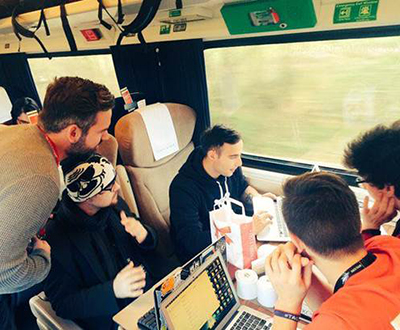HSE Computer Science Faculty Student to Present His Project to British Minister of Transport
Third year software engineering student Vadim Drobinin took part in the Hacktrain hackathon last weekend in Britain (November 21-22). The project, developed by the international team Vadim is part of, will be presented to the British Minister of Transport and compete for 25,000 pounds worth of investment.
 |
| Vadim Drobinin and the team |
The hackathon Hacktrain was all about developing apps to solve railway issues. 120 programmers, designers and entrepreneurs from all over the world spent 48 hours working on the problems onboard trains travelling various routes between London and York. The three hackathon trains each had a different theme - Customer Experience, Big Data and Infrastructure. Vadim’s team was on the Infrastructure train.
‘We designed a system for collecting data on mobile phone signal quality on the whole course of the train journeys and managed to build quite a serious back-end on the basis of kafka + kibana,’ says Vadim. ‘We also made a mobile app which tells you how many people are in each carriage (to find out if there’s a seat free) and draws a thermal map of the quality of connectivity (to find out where new masts should be installed),’
Vadim’s team was selected as one of the strongest in the hackathon. In December they will compete for £25,000 of investment for development and their project, along with the other best projects will be presented to the British Minister of Transport and to four dozen directors of railway and transport companies who all have a vested interest in ideas which could improve railway transport.
See also:
Students from HSE University in Nizhny Novgorod Create Web Service for Recognising Emotions
A team of students from HSE University in Nizhny Novgorod and Minin University have created a mobile application and a web service for recognising emotions in photographs. This solution can be useful in marketing, education, personnel management—any areas where the quality of interpersonal communication matters.
HSE Art and Design School Students Develop Crowswap App for Exchanging Minors
Third-year Design and Coding students Valeria Insafutdinova, Grigory Narinsky and Polina Filacheva have created Crowswap, an app that allows students from different HSE programmes to swap minors and apply for transfers. The app also informs them on where to send all the necessary papers.
Live Pages App Gets New English Translation of ‘War and Peace’
An English-language translation of Lev Tolstoy's War and Peace is now available on the Live Pages mobile app. Students at HSE's Linguistics and Philology Schools were involved in developing this project.
Three New Novels on HSE’s Living Pages Project
Three new novels are now available on the Living Pages app library: Dead Souls by Nikolai Gogol, The Captain's Daughter by Alexander Pushkin, and The Twelve Chairs by Ilya Ilf and Evgeny Petrov. The app was developed by the HSE School of Linguistics together with Samsung and experts from Tolstoy Digital group.
Mobile App Live Pages Wins Runet Prize
A mobile app, developed by the HSE School of Linguistics with Samsung and the Leo Tolstoy State Museum won the Runet Prize 2015 in the Mobile Runet category.
Students at the Faculty of Computer Science Win Apple’s WWDC Scholarship
Second year Software Engineering students Vadim Drobinin and Alexander Zimin have been named the winners of the WWDC Scholarship. In June they will take part in the Apple Worldwide Developers Conference (WWDC), which is an annual international conference for Apple developers held in California 8-12 June.
Two Days — Three Startup Winners
A voice navigator for the visually impaired, English language learning games, teaching computer programming to children are the results of two days intensive work by young people at Hackathon (forum for developing software), Hack for People at the HSE Centre for Prototype Development. The participants had just 48 hours to formulate the concept for a project, write a strategy to promote and create it or fine-tune a prototype.


